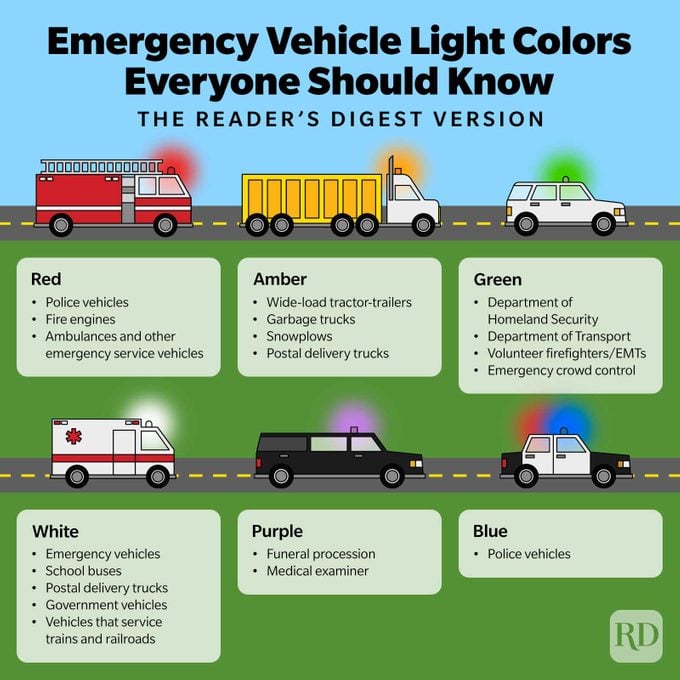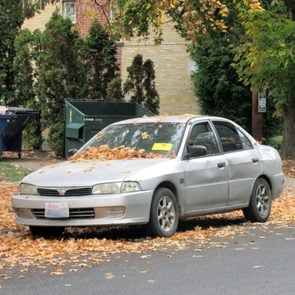Here’s What It Means If You See Green Lights on a Car
Updated: Aug. 16, 2023

We know red lights are for fire trucks and blue are for law enforcement, but what on earth does it mean if you see green lights on cars? We're here to help you see the light.
Being a safe and responsible driver has a lot to do with picking up on the signals from your environment. From red stop signs to green lights on cars to colored balls on power lines, it’s all about knowing and understanding what the different colors and lights mean so that you can make the best decisions as you’re driving.
Admittedly, we still have to look up exactly what all those dashboard lights mean when one of them comes on. But we’re all somewhat familiar with the different traffic light colors, hazard lights, red brake lights and white headlights (including those annoying LED ones), right?
Even if you think you know all the interesting facts about your automobile, there are always more mysteries to unravel. For example, in certain circumstances, you might see green lights on cars and wonder what they mean. Could they be for special vehicles, and should you slow down to let them pass? To help with your on-road dilemmas, we’ve investigated the issue of green lights on cars and unearthed the answer. Set your mind at ease so you can cruise control safely home.
Get Reader’s Digest’s Read Up newsletter for humor, cleaning, travel, tech and fun facts all week long.
What do green lights mean on a car?
The Department of Homeland Security, the Department of Transport, the fire service (often volunteer firefighters or first responders) and command post vehicles all use green lighting. That’s why you’re most likely to see green lights on a car patrolling a government facility or in a town with volunteer firefighting services.
But while red-and-blue lights indicate police no matter where in America you live, the use of green lights on cars differs by state. In some states, green lights—particularly those that are flashing—indicate an emergency vehicle. See one on the road? Follow these driving tips: Pull over to let the vehicle pass, or slow down, move over and pass it.
Depending on where you’re driving, green lights on cars could indicate:
- Department of Homeland Security
- Department of Transport (such as road maintenance vehicles in Michigan)
- Volunteer firefighters or EMTs (in Canada, Indiana and Washington)
- Emergency crowd control, the only time you could see green lights on a police car (in Montana)

Can you put green lights on your car?
The laws about who can put green lights on a vehicle vary from state to state, but in many states, adding green lights to your car isn’t just bad driving etiquette—it’s illegal. In most cases, the law exists to prevent other drivers from confusing your car for an emergency vehicle. There is also a chance that green lights on cars could be mistaken for traffic lights.
In some states (such as North Dakota), you can add green lights to your car as long as they are not flashing lights and are not visible from the front of your car. As always, when modifying your car in any way, it’s best to look up your state’s laws. Otherwise, the next lights you see might be red and blue!
What other emergency lights might you see on cars?
Just like those colored circles on food packages, emergency vehicle lights make good use of the color spectrum. And that helps civilian drivers stay alert to possible emergencies. In addition to green lights on cars, you’re likely to come across the colors below.
Red lights
In almost every situation, forward-facing red lights indicate an emergency vehicle: police, fire or emergency medical services such as ambulances. Red usually means stop—think of stop signs and, of course, tail lights. But when the front lights are red, it’s not a sign you need to press the brakes but a cue for you to pay attention and potentially take action.
In some states, red lights can also indicate a city, county or state police car. Some states use a solid red light and a flashing blue one (California) or vice versa (Nevada) to delineate between police and fire vehicles, while other states add a white light for firefighters (Nebraska) or police (New York and North Dakota). You may also see red lights on funeral hearses in Iowa, tow trucks in Texas and Michigan, and on the front and back of school buses everywhere to remind you to watch for children.
It can be confusing, but the reason for the mix of lights is to be more inclusive. People with color blindness are often able to see either red or blue, so including both on emergency vehicles makes it more likely that everyone will be able to see an emergency vehicle and react appropriately.
Blue lights
Some countries have blue traffic lights, but in the United States, blue is the color most commonly associated with law enforcement, and we’re not just talking about their uniforms. That extends to vehicles as well.
Blue on a patrol car almost always indicates police, even if there are also white or red lights. There are a few states in which law enforcement vehicles use blue lights only (such as Arkansas), but blue often appears alongside other colors.
White lights
Headlights are the most common white lights you’ll see on the road, but you might also catch them flashing on the roof or as part of a light bar on a vehicle. In those cases, the white lights provide contrast with other colored lights. See, while red lights are the most commonly used emergency light color, they can sometimes get lost in a sea of red tail lights, especially in traffic. Using white lights next to red make it easier for drivers to pick out an emergency vehicle. If only it was as easy to pick out a red light camera!
You might see flashing white lights on school buses, postal delivery trucks and other government vehicles, as well as on vehicles that service trains and railroads (such as fueling trucks).
Amber lights
Like the yellow of a traffic light, amber (a warm, orange-tinged yellow) means “slow down” or “prepare to stop” when you see it as a light on a vehicle. Amber is considered a warning light, so you’re not required by law to yield or stop for a vehicle with amber lights on it. (Speaking of those yellow slow-down indicators, here’s a fun fact: Not so long ago, you might have seen yellow stop signs too!)
Because amber lights often appear on slow-moving vehicles, like wide-load tractor-trailers, garbage trucks, snow plows and postal vehicles, it’s polite—and definitely safer—to slow down and give the vehicle room when you can.
Purple lights
And you thought green lights on cars were unusual! Just like purple-painted fences, purple lights are pretty uncommon. But if you see them on a car, know that they have a somber meaning. A vehicle with purple lights is usually part of a funeral procession, such as a hearse. They can also indicate a coroner or medical examiner’s vehicle.
Now that you know what green lights on cars mean—and every other color too—find out what’s going on with those colored squares on toothpaste.
Sources:
- Brooking Technologies: “Can Civilians Use Emergency and Warning Lights in Private Vehicles?”
- Department of Justice: “Law Enforcement Vehicle Lighting and Reflectivity Studies”
- Indiana Volunteer Firefighters Association: “Green Light Law”
- LED Equipped: “Psychology Behind Red and Blue Police Lights”
- Michigan County Roads: “Green lights on road maintenance vehicles”
- Motor Biscuit: “Here’s the Color of Police and Fire Truck Lights in Every State”
- Oznium LED Lighting: “What are the US lighting laws?”
- Star Lighting Products: “Emergency Vehicle Lights and Colors”
- Washington State Legislature: “Green light on firefighters’ private cars”



